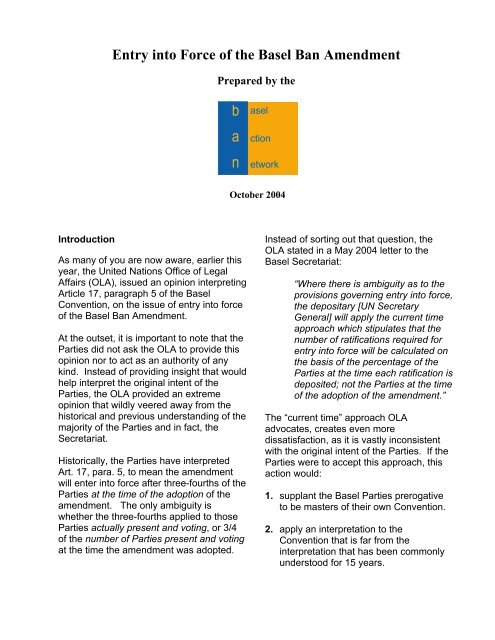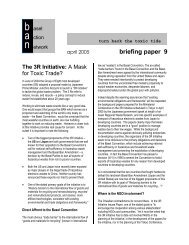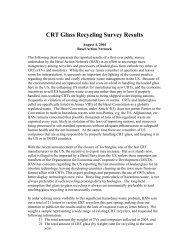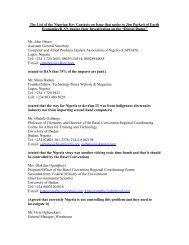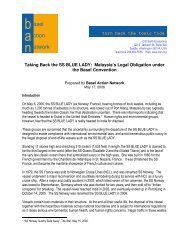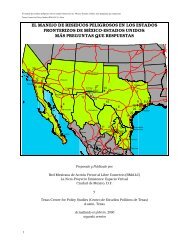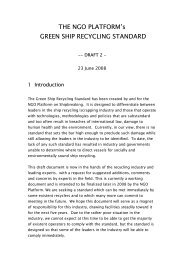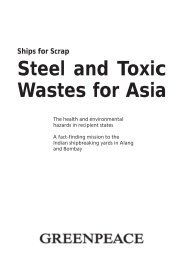Entry into Force of the Basel Ban Amendment - Basel Action Network
Entry into Force of the Basel Ban Amendment - Basel Action Network
Entry into Force of the Basel Ban Amendment - Basel Action Network
You also want an ePaper? Increase the reach of your titles
YUMPU automatically turns print PDFs into web optimized ePapers that Google loves.
Introduction<br />
<strong>Entry</strong> <strong>into</strong> <strong>Force</strong> <strong>of</strong> <strong>the</strong> <strong>Basel</strong> <strong>Ban</strong> <strong>Amendment</strong><br />
As many <strong>of</strong> you are now aware, earlier this<br />
year, <strong>the</strong> United Nations Office <strong>of</strong> Legal<br />
Affairs (OLA), issued an opinion interpreting<br />
Article 17, paragraph 5 <strong>of</strong> <strong>the</strong> <strong>Basel</strong><br />
Convention, on <strong>the</strong> issue <strong>of</strong> entry <strong>into</strong> force<br />
<strong>of</strong> <strong>the</strong> <strong>Basel</strong> <strong>Ban</strong> <strong>Amendment</strong>.<br />
At <strong>the</strong> outset, it is important to note that <strong>the</strong><br />
Parties did not ask <strong>the</strong> OLA to provide this<br />
opinion nor to act as an authority <strong>of</strong> any<br />
kind. Instead <strong>of</strong> providing insight that would<br />
help interpret <strong>the</strong> original intent <strong>of</strong> <strong>the</strong><br />
Parties, <strong>the</strong> OLA provided an extreme<br />
opinion that wildly veered away from <strong>the</strong><br />
historical and previous understanding <strong>of</strong> <strong>the</strong><br />
majority <strong>of</strong> <strong>the</strong> Parties and in fact, <strong>the</strong><br />
Secretariat.<br />
Historically, <strong>the</strong> Parties have interpreted<br />
Art. 17, para. 5, to mean <strong>the</strong> amendment<br />
will enter <strong>into</strong> force after three-fourths <strong>of</strong> <strong>the</strong><br />
Parties at <strong>the</strong> time <strong>of</strong> <strong>the</strong> adoption <strong>of</strong> <strong>the</strong><br />
amendment. The only ambiguity is<br />
whe<strong>the</strong>r <strong>the</strong> three-fourths applied to those<br />
Parties actually present and voting, or 3/4<br />
<strong>of</strong> <strong>the</strong> number <strong>of</strong> Parties present and voting<br />
at <strong>the</strong> time <strong>the</strong> amendment was adopted.<br />
Prepared by <strong>the</strong><br />
b<br />
a<br />
n<br />
asel<br />
ction<br />
etwork<br />
October 2004<br />
Instead <strong>of</strong> sorting out that question, <strong>the</strong><br />
OLA stated in a May 2004 letter to <strong>the</strong><br />
<strong>Basel</strong> Secretariat:<br />
“Where <strong>the</strong>re is ambiguity as to <strong>the</strong><br />
provisions governing entry <strong>into</strong> force,<br />
<strong>the</strong> depositary [UN Secretary<br />
General] will apply <strong>the</strong> current time<br />
approach which stipulates that <strong>the</strong><br />
number <strong>of</strong> ratifications required for<br />
entry <strong>into</strong> force will be calculated on<br />
<strong>the</strong> basis <strong>of</strong> <strong>the</strong> percentage <strong>of</strong> <strong>the</strong><br />
Parties at <strong>the</strong> time each ratification is<br />
deposited; not <strong>the</strong> Parties at <strong>the</strong> time<br />
<strong>of</strong> <strong>the</strong> adoption <strong>of</strong> <strong>the</strong> amendment.”<br />
The “current time” approach OLA<br />
advocates, creates even more<br />
dissatisfaction, as it is vastly inconsistent<br />
with <strong>the</strong> original intent <strong>of</strong> <strong>the</strong> Parties. If <strong>the</strong><br />
Parties were to accept this approach, this<br />
action would:<br />
1. supplant <strong>the</strong> <strong>Basel</strong> Parties prerogative<br />
to be masters <strong>of</strong> <strong>the</strong>ir own Convention.<br />
2. apply an interpretation to <strong>the</strong><br />
Convention that is far from <strong>the</strong><br />
interpretation that has been commonly<br />
understood for 15 years.
3. create a draconian interpretation<br />
whereby amendments face an ever-<br />
increasing, unlimited number <strong>of</strong><br />
necessary ratifications, and at such a<br />
high number as to pose an almost<br />
insurmountable challenge.<br />
The Parties are Masters <strong>of</strong> Their Own<br />
Convention<br />
Unfortunately, ambiguities in international<br />
treaties are all too common. Fortunately,<br />
<strong>the</strong> Parties to a Convention are <strong>the</strong> masters<br />
<strong>of</strong> <strong>the</strong>ir Convention and thus <strong>the</strong> ultimate<br />
determination <strong>of</strong> <strong>the</strong> interpretation <strong>of</strong><br />
ambiguous language lies with <strong>the</strong> Parties.<br />
BAN has conducted research and<br />
questioned several <strong>of</strong> <strong>the</strong> world's foremost<br />
experts in international law. These experts<br />
include Pr<strong>of</strong>essor Alexandre Kiss, President<br />
<strong>of</strong> <strong>the</strong> European Council <strong>of</strong> Environmental<br />
law as well as Pr<strong>of</strong>essor Durwood Zaelke,<br />
author <strong>of</strong> classic texts on international<br />
environmental law including: "International<br />
Environmental Law and Policy" 1998; and<br />
Trade & <strong>the</strong> Environment: Law, Economics,<br />
& Policy" 1993. Mr. Zaelke explains <strong>the</strong><br />
options available to <strong>the</strong> Parties as follows<br />
(and see attached letter).<br />
The Parties now have two choices to<br />
determine an interpretation.<br />
Authoritative Interpretation: The parties<br />
can adopt a decision to cede <strong>the</strong>ir authority,<br />
if <strong>the</strong>y wish, agreeing to accept an<br />
authoritative interpretation (e.g. by an<br />
authority such as <strong>the</strong> OLA).<br />
Au<strong>the</strong>ntic Interpretation: Alternatively, <strong>the</strong><br />
Parties can choose ano<strong>the</strong>r method <strong>of</strong><br />
interpretation known as “au<strong>the</strong>ntic<br />
interpretation” whereby <strong>the</strong> Parties to a<br />
treaty resolve <strong>the</strong> question <strong>the</strong>mselves.<br />
To date, <strong>the</strong> Parties have not adopted a<br />
decision nor have given <strong>the</strong> Secretariat a<br />
2<br />
mandate for which path to take. Thus, <strong>the</strong><br />
OLA opinion is not binding, and in fact is<br />
simply an opinion until <strong>the</strong> Parties take a<br />
formal decision.<br />
O<strong>the</strong>r Precedents<br />
It will hardly be <strong>the</strong> first time an au<strong>the</strong>ntic<br />
interpretation has been reached. The <strong>Basel</strong><br />
Convention Parties need only look at o<strong>the</strong>r<br />
precedents that addressed <strong>the</strong> same issue,<br />
and where Parties to treaties found it<br />
necessary to exert <strong>the</strong>ir sovereign right to<br />
eliminate <strong>the</strong> ambiguities in <strong>the</strong>ir treaties.<br />
CITES: In 1983, <strong>the</strong> Conference <strong>of</strong> <strong>the</strong><br />
Parties to <strong>the</strong> Convention on International<br />
Trade in Endangered Species <strong>of</strong> Wild<br />
Fauna and Flora (CITES) resolved an<br />
almost identical ambiguity that was found in<br />
<strong>the</strong>ir Article XVII, paragraph 3, by adopting<br />
<strong>the</strong> following recommendation:<br />
“Recommends that <strong>the</strong> meaning <strong>of</strong><br />
Article XVII, paragraph 3, <strong>of</strong> <strong>the</strong><br />
Convention be interpreted in its<br />
narrow sense so as to mean that <strong>the</strong><br />
acceptance <strong>of</strong> two-thirds <strong>of</strong> <strong>the</strong><br />
Parties at <strong>the</strong> time <strong>of</strong> <strong>the</strong> adoption <strong>of</strong><br />
an amendment is required for <strong>the</strong><br />
coming <strong>into</strong> force <strong>of</strong> such<br />
amendment.” (see attached)<br />
RAMSAR: In 1990, <strong>the</strong> Ramsar Convention<br />
on Wetlands similarly followed <strong>the</strong> CITES<br />
Resolution precedent in interpreting <strong>the</strong><br />
ambiguity <strong>of</strong> <strong>the</strong>ir two-thirds requirement in<br />
Art. 10 par. 6 <strong>of</strong> <strong>the</strong> Ramsar Convention<br />
(see attached).<br />
These are two recent, relevant and very<br />
similar instances to <strong>the</strong> <strong>Basel</strong> Convention<br />
situation where <strong>the</strong> Parties involved chose<br />
to exercise <strong>the</strong>ir sovereignty and choose an<br />
au<strong>the</strong>ntic interpretation, thus clearing up <strong>the</strong><br />
ambiguity in <strong>the</strong>ir Conventions in a manner<br />
reflecting <strong>the</strong> will <strong>of</strong> <strong>the</strong> Parties.
The Will <strong>of</strong> <strong>the</strong> <strong>Basel</strong> Parties: Early <strong>Entry</strong><br />
<strong>into</strong> <strong>Force</strong><br />
There can be no doubt that <strong>the</strong> will <strong>of</strong> <strong>the</strong><br />
<strong>Basel</strong> Parties with respect to <strong>the</strong> <strong>Basel</strong> <strong>Ban</strong><br />
<strong>Amendment</strong> has always been one <strong>of</strong><br />
urgency.<br />
3<br />
It has been highest on <strong>the</strong> agenda <strong>of</strong> <strong>the</strong><br />
first four conferences <strong>of</strong> <strong>the</strong> Parties and has<br />
facilitated <strong>the</strong> following decisions at every<br />
Conference <strong>of</strong> <strong>the</strong> Parties. Urgency and<br />
unanimity, has been noted every step <strong>of</strong> <strong>the</strong><br />
way as indicated in <strong>the</strong> table below:<br />
Decision Indicators <strong>of</strong> Urgency and Support<br />
I/22 Passed by consensus<br />
II/12 Passed by consensus, Calls for all Parties to “work actively to ensure<br />
effective implementation.” Called for all such waste trade to cease by 1998.<br />
III/1 Passed by consensus. Called for all such waste trade to cease by 1998.<br />
IV/7 Passed by consensus, “strongly appeals to Parties to ratify <strong>the</strong> <strong>Amendment</strong><br />
as soon as possible to enable <strong>the</strong> early entry <strong>into</strong> force.”<br />
IV/8 Passed by consensus, refers to “urges Parties to ratify this <strong>Amendment</strong> as<br />
a matter <strong>of</strong> priority.”<br />
V/3 Passed by consensus, “strongly appeals to Parties to ratify <strong>the</strong> amendment<br />
as soon as possible to facilitate early entry <strong>into</strong> force.”<br />
VI/33 Passed by consensus, “strongly appeals to Parties to expedite <strong>the</strong> process<br />
<strong>of</strong> ratification <strong>of</strong> <strong>the</strong> <strong>Amendment</strong> to facilitate its entry <strong>into</strong> force at <strong>the</strong><br />
earliest opportunity.”<br />
The “current time” model, if accepted by<br />
<strong>the</strong> Parties, would dramatically delay and<br />
perhaps prevent <strong>the</strong> entry <strong>into</strong> force <strong>of</strong> <strong>the</strong><br />
<strong>Ban</strong> <strong>Amendment</strong>, <strong>the</strong> creation <strong>of</strong> which <strong>the</strong><br />
Parties spent thousands <strong>of</strong> person-hours<br />
and many millions <strong>of</strong> dollars. It would<br />
work against <strong>the</strong> language <strong>of</strong> repeated<br />
<strong>Basel</strong> decisions calling for early entry <strong>into</strong><br />
force.<br />
To demonstrate <strong>the</strong> undue and<br />
inappropriate burden <strong>the</strong> current time<br />
<strong>Basel</strong> <strong>Entry</strong> <strong>into</strong> <strong>Force</strong><br />
Instrument Requirement<br />
<strong>Basel</strong><br />
Convention<br />
20 Parties<br />
Liability<br />
Protocol<br />
20 Parties<br />
Adding Automatic after 6<br />
Annexes months<br />
Amending Text Auutomatic after 6<br />
months<br />
<strong>Basel</strong> <strong>Ban</strong> 122+ Parties (current<br />
<strong>Amendment</strong> time interpretation)?
interpretation would place on such an<br />
amendment, consider in <strong>the</strong> table above,<br />
<strong>the</strong> existing requirements for an<br />
<strong>Amendment</strong> to enter <strong>into</strong> force in<br />
comparison with o<strong>the</strong>r similar <strong>Basel</strong><br />
Convention instruments.<br />
As can be seen, <strong>the</strong> undue burden that<br />
would be placed upon <strong>the</strong> <strong>Basel</strong> <strong>Ban</strong><br />
<strong>Amendment</strong> is disproportionate to any<br />
o<strong>the</strong>r similar decision by a factor <strong>of</strong> more<br />
than 6. This is clearly far, far away from<br />
what has been, and is expected, by <strong>the</strong><br />
Parties as an adequate measure <strong>of</strong><br />
support for entry <strong>into</strong> force <strong>of</strong> <strong>Basel</strong><br />
instruments.<br />
Recommendation<br />
The <strong>Basel</strong> Convention is what it is today<br />
because <strong>of</strong> <strong>the</strong> Parties. Every letter, every<br />
word, every decision, every guideline, was<br />
achieved through <strong>the</strong> work <strong>of</strong> all <strong>the</strong> <strong>Basel</strong><br />
Parties. They are <strong>the</strong> ones bound by it,<br />
and it is only correct that <strong>the</strong> Parties<br />
<strong>the</strong>mselves determine every decision.<br />
Likewise <strong>the</strong> true determination <strong>of</strong> <strong>the</strong><br />
meaning <strong>of</strong> Art. 17, para. 5 <strong>of</strong> <strong>the</strong> <strong>Basel</strong><br />
Convention should be concluded by <strong>the</strong><br />
Parties in <strong>the</strong> spirit <strong>of</strong> consensus, past and<br />
<strong>Basel</strong> <strong>Action</strong> <strong>Network</strong><br />
c/o Asia Pacific Environmental Exchange<br />
1305 4 th Ave., Ste. 606, Seattle, WA.<br />
USA 98101<br />
Telephone: 1.206.652.5555, Fax:<br />
1.206.652.5750<br />
E-mail: info@ban.org<br />
Website: www.ban.org<br />
4<br />
present and in <strong>the</strong> spirit <strong>of</strong> <strong>the</strong> consistent<br />
call for urgency in entry <strong>into</strong> force <strong>of</strong> <strong>the</strong><br />
<strong>Basel</strong> <strong>Ban</strong> <strong>Amendment</strong>.<br />
It is never appropriate to press for<br />
revisionism in a treaty but to press for <strong>the</strong><br />
original intent and general understanding<br />
<strong>of</strong> a majority <strong>of</strong> Parties.<br />
As we have seen, <strong>the</strong> UN Office <strong>of</strong> Legal<br />
Affairs (OLA) opinion if it were to be<br />
accepted would depart from original intent,<br />
would equate to a massive waste <strong>of</strong><br />
United Nations and national resources<br />
involved in amendment negotiation, and<br />
will lead to unintended consequences<br />
including <strong>the</strong> possibility that <strong>the</strong><br />
<strong>Amendment</strong> will never enter <strong>into</strong> force or<br />
will enter <strong>into</strong> force far too late for it to<br />
serve as it was intended.<br />
There remains little choice but for <strong>the</strong><br />
Parties to assert <strong>the</strong>ir proper role and set<br />
forth an unequivocal au<strong>the</strong>ntic<br />
interpretation in a decision clearing <strong>the</strong><br />
ambiguity on Art. 17, para. 5 in favor <strong>of</strong><br />
ei<strong>the</strong>r 3/4ths <strong>of</strong> <strong>the</strong> number <strong>of</strong> Parties<br />
present and voting at <strong>the</strong> time <strong>of</strong> <strong>the</strong><br />
amendment’s adoption.
Mr. Jim Puckett<br />
Coordinator<br />
<strong>Basel</strong> <strong>Action</strong> <strong>Network</strong><br />
1305 4 th Ave., Suite 606<br />
Seattle, WA 98101<br />
USA<br />
Dear Mr. Puckett,<br />
Institute for Governance & Sustainable<br />
Development<br />
Re: <strong>Basel</strong> Treaty Interpretation<br />
5<br />
19 October 2004<br />
I am writing in response to your inquiry on <strong>the</strong> opinion issued by <strong>the</strong> Chief <strong>of</strong> <strong>the</strong> Treaty Section <strong>of</strong> <strong>the</strong><br />
United Nation Office <strong>of</strong> Legal Affairs in its attempt to resolve <strong>the</strong> ambiguity in Article 17(5) <strong>of</strong> <strong>the</strong> <strong>Basel</strong><br />
Convention, specifically, <strong>the</strong> number <strong>of</strong> ratifications required for <strong>the</strong> <strong>Basel</strong> <strong>Ban</strong> <strong>Amendment</strong> to enter <strong>into</strong><br />
force.<br />
While treaty ambiguities are not uncommon, it is in <strong>the</strong> power <strong>of</strong> <strong>the</strong> Parties to a Convention—<strong>the</strong> treaty<br />
constituents—to choose <strong>the</strong> method <strong>of</strong> interpretation to resolve ambiguities.<br />
One method is called “authoritative interpretation”, which is when <strong>the</strong> Parties request an opinion from a<br />
designated external institution, such as <strong>the</strong> treaty depositary. The <strong>Basel</strong> Secretariat took this approach,<br />
although it is still within <strong>the</strong> power <strong>of</strong> <strong>the</strong> Parties to decide whe<strong>the</strong>r or not to accept such an<br />
interpretation.<br />
The o<strong>the</strong>r method is called “au<strong>the</strong>ntic interpretation”, which is done when Parties resolve <strong>the</strong> question<br />
<strong>the</strong>mselves. This method was followed by <strong>the</strong> Conference <strong>of</strong> <strong>the</strong> Parties to CITES in 1983 to resolve a<br />
very similar ambiguity in Article XVII, paragraph 3, <strong>of</strong> <strong>the</strong> CITES Convention.<br />
As you will see from CITES Resolution Conf. 4.25 (attached), <strong>the</strong> Parties rejected <strong>the</strong> “current time<br />
approach”, which I understand is <strong>the</strong> proposed resolution recommended by <strong>the</strong> Chief <strong>of</strong> <strong>the</strong> Treaty<br />
Section <strong>of</strong> <strong>the</strong> UN Office <strong>of</strong> Legal Affairs. While <strong>the</strong>oretically, <strong>the</strong> CITES Conference can only<br />
“recommend” action, resolutions have been followed by Parties as if <strong>the</strong>y were binding.<br />
See also, Ramsar Convention Resolution IV.1: Interpretation <strong>of</strong> Article 10 bis Paragraph 6 <strong>of</strong> <strong>the</strong><br />
Convention (1990), which follows <strong>the</strong> CITES Resolution Conf. 4.27 in interpreting <strong>the</strong> ambiguity <strong>of</strong> <strong>the</strong><br />
two-thirds requirement.
Mr. Jim Puckett<br />
19 October 2004<br />
Page 2<br />
These are but two recent and relevant instances where <strong>the</strong> “au<strong>the</strong>ntic interpretation” approach was<br />
utilized by <strong>the</strong> Parties; <strong>the</strong>re are many more instances where Parties have resolved interpretation<br />
issues <strong>the</strong>mselves in a manner consistent with <strong>the</strong>ir intentions.<br />
In summary, <strong>the</strong> selection <strong>of</strong> <strong>the</strong> appropriate method in removing <strong>the</strong> ambiguity in Art. 17 <strong>of</strong> <strong>the</strong> <strong>Basel</strong><br />
Convention is entirely <strong>the</strong> sovereign/democratic choice <strong>of</strong> <strong>the</strong> Parties <strong>the</strong>mselves. The Parties are <strong>the</strong><br />
masters <strong>of</strong> <strong>the</strong>ir own instrument.<br />
Best Regards,<br />
Durwood Zaelke<br />
Institute for Governance & Sustainable Development<br />
President<br />
Att. CITES Resolution Conf. 4.27<br />
Ramsar Convention Resolution IV.1<br />
6
Conf. 4.27<br />
Interpretation <strong>of</strong> Article XVII, paragraph 3, <strong>of</strong> <strong>the</strong> Convention<br />
RECOGNIZING that <strong>the</strong> Convention can only operate and be effective if <strong>the</strong> Conference <strong>of</strong> <strong>the</strong><br />
Parties defines <strong>the</strong> provisions <strong>of</strong> <strong>the</strong> Convention in line with <strong>the</strong> basic principles which gave birth<br />
to it;<br />
ACKNOWLEDGING that Article XVII, paragraph 3, <strong>of</strong> <strong>the</strong> Convention could be legally defended in<br />
both its narrow and wide interpretations;<br />
CONSIDERING <strong>the</strong> difficulties which might result from a wide interpretation <strong>of</strong> Article XVII,<br />
paragraph 3, <strong>of</strong> <strong>the</strong> Convention;<br />
CONSIDERING that any amendment to <strong>the</strong> present Convention could not enter <strong>into</strong> force unless<br />
a limitation is established as to <strong>the</strong> number <strong>of</strong> Parties required for <strong>the</strong> coming <strong>into</strong> force <strong>of</strong> an<br />
amendment;<br />
THE CONFERENCE OF THE PARTIES TO THE CONVENTION<br />
RECOMMENDS that <strong>the</strong> meaning <strong>of</strong> Article XVII, paragraph 3, <strong>of</strong> <strong>the</strong> Convention be interpreted<br />
in its narrow sense so as to mean that <strong>the</strong> acceptance <strong>of</strong> two-thirds <strong>of</strong> <strong>the</strong> Parties at <strong>the</strong> time <strong>of</strong><br />
<strong>the</strong> adoption <strong>of</strong> an amendment is required for <strong>the</strong> coming <strong>into</strong> force <strong>of</strong> such amendment.<br />
7
RAMSAR RESOLUTION<br />
4th Meeting <strong>of</strong> <strong>the</strong> Conference <strong>of</strong> <strong>the</strong> Contracting Parties<br />
Montreux, Switzerland<br />
27 June-4 July 1990<br />
Resolution IV.1: Interpretation <strong>of</strong> Article 10 bis Paragraph 6 <strong>of</strong> <strong>the</strong> Convention*<br />
RECALLING that amendments to Articles 6 and 7 <strong>of</strong> <strong>the</strong> Convention were adopted on 28 May 1987 in<br />
Regina, Canada;<br />
BEING AWARE that Article 10 bis paragraph 6 <strong>of</strong> <strong>the</strong> Convention provides that an amendment adopted<br />
shall enter <strong>into</strong> force for <strong>the</strong> Contracting Parties which have accepted it on <strong>the</strong> first day <strong>of</strong> <strong>the</strong> fourth<br />
month following <strong>the</strong> date on which two-thirds <strong>of</strong> <strong>the</strong> Contracting Parties have deposited an instrument <strong>of</strong><br />
acceptance with <strong>the</strong> Depositary;<br />
CONSIDERING that <strong>the</strong>re is a need to dispel any ambiguity as to <strong>the</strong> date on which amendments enter<br />
<strong>into</strong> force;<br />
THE CONFERENCE OF THE CONTRACTING PARTIES<br />
DECIDES that in order to determine <strong>the</strong> date <strong>of</strong> <strong>the</strong> entry <strong>into</strong> force <strong>of</strong> any amendment to <strong>the</strong><br />
Convention, <strong>the</strong> expression "two-thirds <strong>of</strong> <strong>the</strong> Contracting Parties" in paragraph 6 <strong>of</strong> Article 10 bis shall<br />
be interpreted as meaning two-thirds <strong>of</strong> <strong>the</strong> Contracting Parties at <strong>the</strong> time <strong>of</strong> <strong>the</strong> adoption <strong>of</strong> that<br />
amendment.<br />
* Note: The operative part <strong>of</strong> this resolution is based on <strong>the</strong> corresponding paragraph <strong>of</strong> CITES<br />
Resolution Conf.4.27 and is intended to serve <strong>the</strong> same purpose.<br />
8


